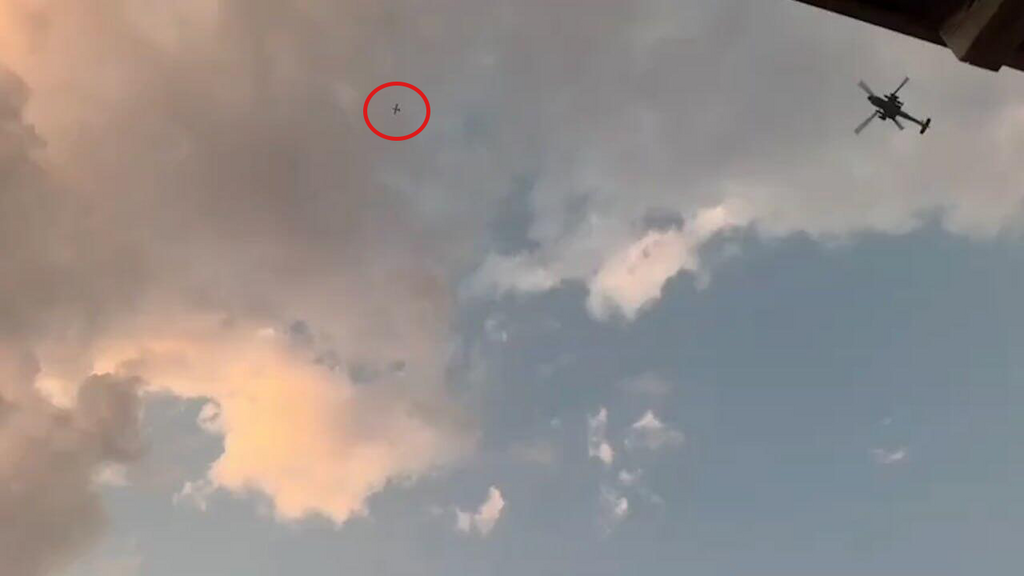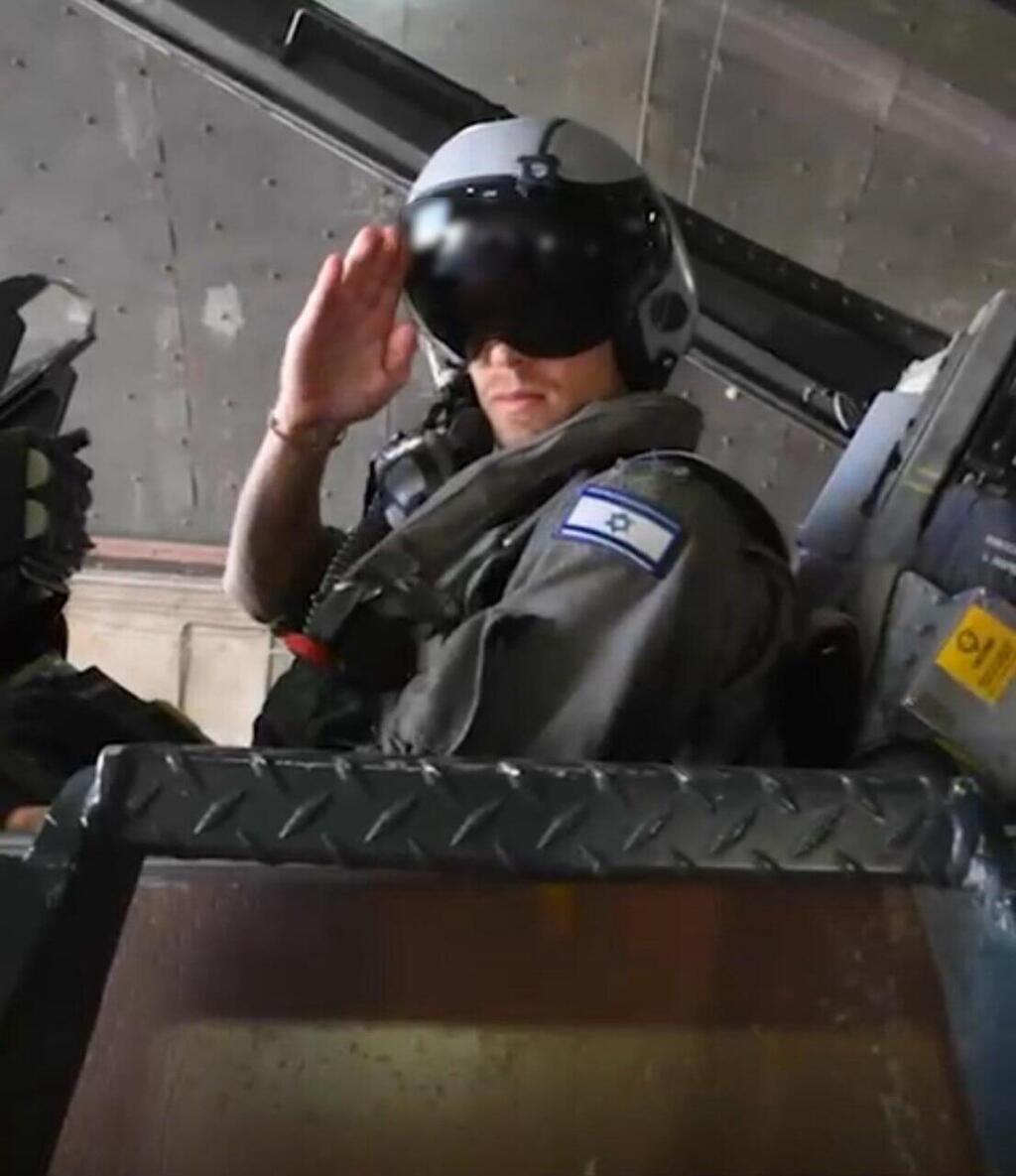Getting your Trinity Audio player ready...
For 34 minutes last Saturday, fighter jets and helicopters escorted a Hezbollah drone until it was shot down. The drone crossed the border over Shlomi in the Western Galilee and continued flying unchallenged over Nahariya, Acre and Haifa, reaching open land near Binyamina.
Once possible, reservist Major A., an Apache helicopter pilot from the 190th Squadron, locked onto it with his sight and fired a barrage of shells.
UAV shot down over Binyamina
(Video: IDF Spokesperson's Unit)
The incident concluded within seconds. Civilians who witnessed the successful interception from the ground immediately uploaded footage to social media. Moments later, the message "The incident has concluded" reached hundreds of thousands of Israelis who had taken shelter.
"We followed it for a long time," Major A. recounted to Ynet and Yedioth Ahronoth. "We waited for a moment when we could ensure that the helicopter's cannon shells wouldn't hit civilians, houses or cars below us. I saw there were clear fields and brought it down."
Tension in the cockpit and on the radio was high, with every second being critical. Decisions had to be made quickly. In the control room of the Air Force command and the Apache squadron dispatched for the mission, there was a strong desire to prevent the "enemy aircraft intrusion" alert, which had turned many areas red, from ending in disaster.
Last month, in the same area, a drone exploded at a Golani training base near Binyamina without warning, killing four soldiers and injuring dozens. On Sunday, a missile boat intercepted a drone over the sea off the coast of Caesarea.
Since the outbreak of the war, Hezbollah has been launching drones toward Israel almost daily. These aircraft can sometimes evade air defense systems more easily, as they are not adequately prepared for the threat. In over a year of war, Israel has been attacked by drones from Yemen, Iraq, Syria, Iran and Lebanon.
Suicide drones targeting specific locations are harder to intercept for various reasons: their small size, flight path and sometimes low altitude. Additionally, they are often launched from locations near the border, significantly reducing the response time for air defense systems.
Israel’s air defense array is designed to detect, track and intercept hostile aircraft before they cross the border. The system issues warnings and follows the aircraft until they can be neutralized. Key to this process is the time the IDF has to intercept the target, which varies depending on whether it's heading toward a military base in the Western Galilee, a defense facility or a high-profile location like the prime minister’s residence in Caesarea. Each target presents a different operational window for a successful interception.
According to the Air Force, about 1,300 drones have been launched toward Israel from all fronts since the war began. Of these, 231 hit the ground. This means that approximately 82% were successfully intercepted.
The military is trying to target the source of the drone launches, Hezbollah's secretive air Unit 127. Despite the elimination of its commander, Mohammad Sarour, in a strike in Beirut's Dahieh district at the end of September, it has relatively retained its strength—only about ten percent of the terrorists in the unit have been killed so far. According to IDF, Hezbollah retains about 30% of its drone arsenal, with the majority destroyed in strikes on warehouses and launch sites.
Returning to the drama over Binyamina's skies, seconds before the cheers of residents who documented the chase and did not heed defense instructions. In the Air Force's control unit sat Major N., the air controller who led the mission to shoot down the drone.
"We scrambled fighter jets and helicopters at it and waited for an interception opportunity," he described. However, the Air Force admits that in reality, they still fail to intercept a significant portion of the drones. Fortunately, many such offensive aircraft miss their intended targets and fall in open areas or collide with objects, such as the residential tower in Nahariya in September and a suspension bridge in the city last week.
Civilian limitations
These are usually relatively small aircraft, weighing as little as 7-9 lbs. and flying slowly. In many cases, they appear on radar systems like birds, cars or clouds. Alongside sky observers recently deployed along the borders, parallel systems are activated in an attempt to detect any launch of such an aircraft and shoot it down before it crosses the border. The assessment of whether the response to destroy the threat will come from the Iron Dome, aircraft or attack helicopters is done quickly.
"Every weapon system has proximity limitations to certain sites," explained Major N. "We also need to protect civilians from the munitions.
"In the year of fighting, we've undergone a rapid evolution in dealing with drones. We started with detection gaps, not seeing all threats in time. Sometimes we didn't even know how to alert them. We acquired dozens of detection and warning systems, and today we can see more than 90% of the threats. The interception rate stands at about 70% of them."
The new systems can quickly determine whether the incoming object is a bird, for example, and if there's any doubt about the type of alert received. Within moments, fighter jets are sent skyward, and pilots are called to locate and identify who stands before them with their eyes.
"Every month, there's a new means to improve interceptions and defense systems," said Major N. "Our situation is much better now. Initially, it took us minutes to launch the first interceptor missile. Today, a missile is already launched at it within a second."
Major (res.) Y. is an F-16 pilot in the veteran 101st Squadron, and his family was evacuated from Kibbutz Yiftach on the Lebanese border. Over the past year, he has participated in dozens of sorties across various fronts. Major Y. says the required response from him and his colleagues against the new threat is immediate.
For example, last month, he was scrambled in the middle of the night from sleep, boarded a plane and flew toward the mission defined for him. Within minutes, the airborne threat was destroyed, even before crossing the border. In his view, "The main challenge is finding an appropriate opportunity to intercept it without causing more significant damage than the device itself can inflict."
In the nick of time
Air battles against drones can be seen in the north almost daily, in pursuits that usually end with an interception. Major Y. says that downing the aircraft is often more challenging than any other task. "We have a lot of power and maneuverability in fighter jets," he explained, "but it's tough to detect and shoot down these small devices. It's like looking for an ant on the road while you're on a fast motorcycle. A fighter jet is designed to engage large aerial targets and attack ground targets. But we still manage to provide a satisfactory response to these aircraft as well."
Major Y. does not reveal where the drone he intercepted in the air chase about last month originated. "Its route was relatively clear—on its way to one of the big cities," he noted. "You know that if you don't shoot it down, there's a chance it will cause damage. It's more stressful than attacking in Lebanon, which you do from an altitude of 30,000 feet. Minutes earlier, I woke up from the siren and the scramble for action. While shaking off the throes of sleep, you must organize for interception, identify the device and reach a certain altitude. At the last second, you press the button and launch a missile at it."
Drone shot down over Binyamina
The 101st Squadron boasts the highest number of enemy aircraft downed in Israel's wars—161 enemy planes. The Air Force has not engaged in air-to-air combat in recent decades, and no additional decorations have been added to the squadron's illustrious wall of downings. It is conceivable that the pilots may now lay the foundation for a new wall marking drone downings. "True, it's not a fighter jet but another attacking aircraft, but in practice, we are here to defend the nation's skies. It doesn't matter what the threat is or its size—the main thing is to shoot it down," said Major Y.
Assessment: Prime Minister's residence could be targeted again
Meanwhile, about two weeks after a drone hit the residence of Prime Minister Benjamin Netanyahu in Caesarea, another attempt to hit the location was apparently made on Sunday. From the investigation of the drone attack, it appears that at 5:30 PM, two drones were launched simultaneously. One exploded in an open area near Elyakim, causing no damage or injuries, while the second target was intercepted by the Navy before it crossed into Israeli territory.
The combined drone formation was likely on its way to the prime minister's residence in Caesarea, and the unit responsible for personnel security was updated on the event and instructed to take defensive measures. IDF identified the drone launches and their flight path. Northern Command updated the security coordinators in the frontline communities, indicating that the increased fire from Lebanon, both rockets and drones, is expected to continue—across and deep into the entire sector.
Get the Ynetnews app on your smartphone:








